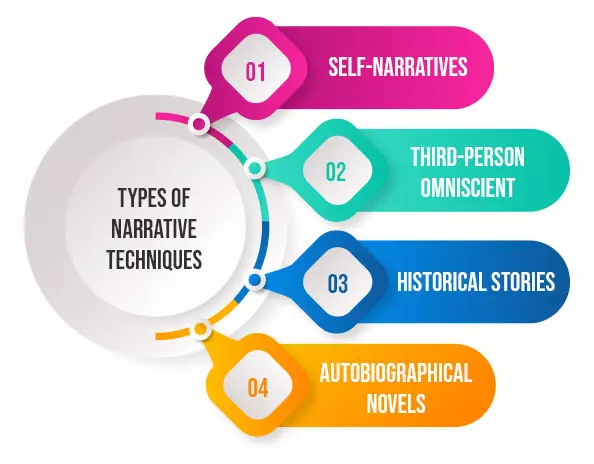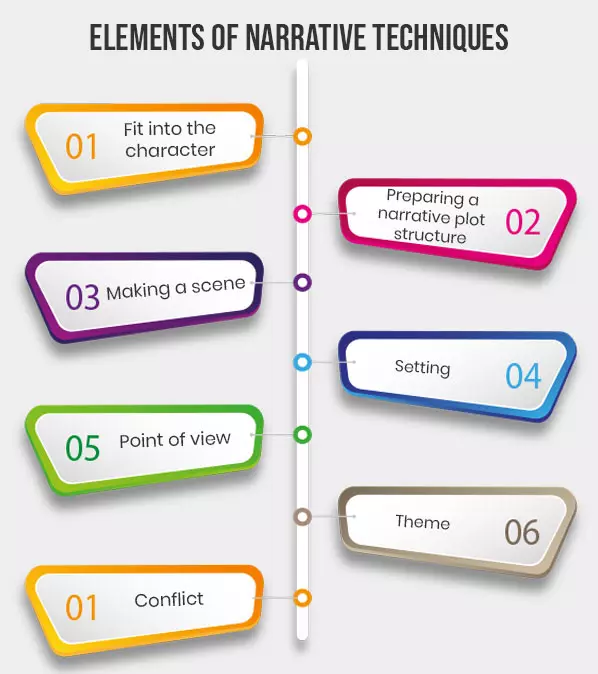Narrative conventions are tools that help tell a story. They include things like plot twists, character growth, and symbols. These techniques help authors convey meaning and connect with readers. By using conventions effectively, writers can make their stories more engaging and memorable. This draws readers in and leaves a lasting impact.
Do you know about narrative conventions? Are you aware of the most common elements of narrative techniques? If you have no idea, then continue reading this blog post. From here, you will understand everything about the narrative convention, its types, and its importance.
What are Narrative Conventions?
Narrative Conventions are procedures used to narrate a story and connect events. In simple terms, narrative convention can be defined as a technique that authors use to convey certain information. There are several types of narratives, such as folk tales, dramas, novels, fables, poetry, and short stories. In general, narrative conventions can be seen in music and cinema.
Moreover, your writing on Narrative Essay Topics should not confuse the viewers about time, events, or space. Generally, the characters should be active and goal-oriented. Narrative convention depends on the spoken or written words and the visible representation of people. Also, these techniques concentrate on the lives of people as narrated by their own stories. In narrative writing, plot development, the character is an important feature.
Furthermore, it is a famous artwork for both teachers and students as it provides them with the opportunity to write with their own imagination, clarity of elements, skill, and creativity. Additionally, its purpose is to narrate the story to an audience in an engaging way. More than that, it is written to entertain, educate, and motivate people. Also, it is a challenging task to engage the audience in the story.
There are two sides to narrative conventions.
1. Primary narrative conventions
2. Secondary narrative conventions
Primary Narrative Conventions
Primary narrative conventions are methods that are used to make a direct effect on the literary content. The primary narrative conventions include conflict, setting, theme, plot development, descriptive language, characters, point of view, and characterization.
- Conflict: Against the Society, Self, Another Person, and Environment
- Setting: Destination Setting, Period Setting
- Theme: Core Theme, Motifs, Symbol
- Plot Development: Denouncement, Exposition, Falling Tension, Complication, Climax
- Descriptive Language: Figurative Language, Imagery, Sensory Imagery
- Characters: Antagonist, Protagonist
- Characterization: Interaction and Relationships, Appearance, Thoughts, Behavior, Dialogues
- Point of View: First Person, Second Person, Third Person
Secondary Narrative Conventions
Secondary narrative conventions are methods that are used to make an impact, but not through the literary content. The following are some common secondary narrative conventions.
- Tone- It is the author’s attitude towards a particular topic. Some examples of tones are sarcastic, frightened, excited, bossy, or depressed.
- Character development- It is the process of developing an original, three-dimensional character with depth, personality, and clear motivations. Also, it refers to the changes a character goes through over the course of a story as a result of certain actions or situations.
- Voice- It is the voice from which a story is told. Moreover, it directly contributes to a character or scene’s tone and mood. The voice mainly helps the authors in building a desired effect on the words they wish to create an impact on the readers.
- Mood- It refers to the atmosphere or ambiance of a piece of writing. In simple terms, it is a feeling that an author tries to evoke in their readers. Some common types of moods are calmness, anxiety, anger, and joy.
Also Read: A Very Old Man With Enormous Wings Summary
Different Types of Narrative Techniques
Mainly, in order to create powerful stories, the writers use several narrative techniques or conventions. Find here some commonly used narrative techniques.

1. Self-narratives
Usually, they are characterized by the writer or a character of the story using their own voice to narrate the story. In this technique, the narrator refers to himself as I and, he may not be the main character in the story. So, the narrator may or may not have an idea of what action should have been revealed in the story. Consequently, this technique is used in writing mystery novels, memoirs, and personal diaries. In such writings, the narrator usually discusses himself.
Also Read: How to Write a Personal Narrative
2. Third-person omniscient
The author uses the third person to narrate the story. Third-person narrators are referred to by their names or pronouns like he, she, or they. The third-person narrator doesn’t always reveal all the information about the past and present. They are used for communicating with the readers directly. The author uses an outside narrator who knows everything.
3. Historical stories
In this type, the narrator tries to impart information about the manners and conditions of the past with details of historical facts. These historical events rely on the lives of real people, with some fictional characters and incidents added to the story. Its subgenres are mysteries, historical research, adventure novels, sagas, series, fantasy, and historical romantic fiction.
4. Autobiographical novels
This kind of writing revolves around the personal life of the narrator. The characters’ roles are also from real-life friends or colleagues of the author. The semi-autobiographies, if they do not meet these requirements, are far from true facts and events. It uses auto-fiction techniques.
Key Elements of Narrative Techniques
The elements of narrative conventions are:

1. Fit into the character
Fiction writing adopts the procedure of developing its characters into a real existing person, as the movie actors prepare for their characters. A clear understanding of these details helps the writer to recognize each other’s background, relationships, interests, important facts, and fears. The writer also tries to have a better understanding of how the character appears, how he looks and speaks, how other people perceive him, and his major idea to accomplish in the story.
2. Preparing a narrative plot structure
It is important to know that your story is built on a structured foundation. Stories are basically plotted on two pillars. In the first pillar, the main character of the story is introduced, which makes the story move. In the second pillar, the important events take place where the action happens, and characters are prepared for the motion of the story.
3. Making a scene
A scene created with dialogue, action, and story in detail. Scenes inject life into stories; viewers can feel the imagery, feel the characters, and their response to the characters. These scenes must have been saved for crucial matters like action sequences and plot developments. Less important events should have been explained in not more than two sentences.
4. Setting
The setting means that when you get the feel of the play and you end up in another universe. This element is extremely important. It establishes the environment, place, and time in which the character and narrator perform. Making a quality setting of play differentiates between the story, which is believable, and the one that does not impress at all.
5. Point of view
This segment supports the reader in recognizing the desires behind the story. Building a point of view is essential for the poem. Forming a persistent view of the story may be difficult.
6. Theme
This element will help the narrator focus on the narration. Having a clear understanding of the theme will help you and your team to reach the book to the audience. Thus, the theme should be clear.
7. Conflict
It affects the plot and helps in character motivation. The narrator should be clear about the determining conflict that inspired the story. This motivates the readers to have empathy with the narrator and characters to understand the work and enjoy the intricacy of the story.
Examples of Narrative Techniques in Style
1. Imagery: This creates an appealing vision for the readers. ‘It was a dark and scary night’. This sentence makes the reader visualize the scene and feel the prospects. They bring sensory perceptions to our minds and
2. Hyperbole: The author emphasizes that the reader understands a strong impression and feelings.
e.g., I have a thousand issues to solve
I have explained this a million times before.
3. Personification: This is used when an inanimate thing is given the characteristics of a human or an animal.
e.g., My new house is a real beauty.
Conclusion
We hope you now have a clear idea about narrative conventions and their importance in literature. If you have strong knowledge of narrative conventions, you can easily narrate a story in an interesting manner and can hold the attention of the readers till the climax. In case you are unsure of how to use narrative techniques in your work, reach out to us. Our team consists of several literature assignment help experts to offer customized essay help online. Simply by using their expertise and knowledge, they will assist you in using the narrative conventions effectively in your work.



